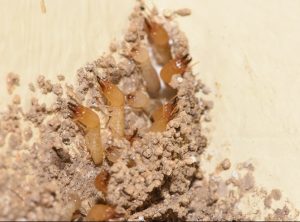A stealthy and determined force of nature, termites are a cause of stress and worry for many homeowners throughout the United States, especially in the Gulf Coast region. Commonly referred to as “the silent destroyers,” termites will silently feed on the wood and other materials within homes 24 hours-a-day, 7-days-a-week.
If left untreated, termites are capable of causing costly damage to the structural wood of your most valuable possession – your home. The National Pest Management Association estimates that termites are responsible for $5 billion in property damage every year in the U.S.2
Termites are small, ant-like insects. However, they differ from ants in that they generally feed off the cellulose in wood. Working largely undetected under the surface, they can tunnel through the wooden structure of buildings and completely destroy them. Wood that comes in contact with the soil, such as the exterior trim on your home, provides a perfect point of entry for a termite colony.
There are many types of termites, with the most common and dangerous ones being subterranean termites. Some common physical characteristics of the subterranean termites include wings, six legs and an antenna. They are between 1/8” to 1” in size, and generally long, oval or narrow in shape. Perhaps their most distinctive trait is their creamy brown color.
Subterranean termites (variations include Eastern subterranean, Western subterranean, Formosan termites, Desert subterranean) originate in the soil as it provides optimal temperatures and moisture for their survival. They may live in areas above the ground or completely underground, and are known to build tunnels to transport food. They grow quickly and build new colonies yearly.
In the spring, large numbers of winged termites, known as “swarmers,” typically emerge inside homes. Spring typically is when large numbers of winged termites, known as “swarmers,” emerge inside homes. Triggered by warmer temperatures and rainfall, the winged termites emerge from the colony and fly into the air, and then swarm to disperse and start new colonies. If Subterranean termites colonies get big enough (colonies as large as two million have been reported3), they will further disperse and create satellite colonies.
Unlike most termites that only feed on wood, these termites feed on almost everything including beams, sub-flooring, insulation, foundation and plastic plumbing pipes. Coupled with their non-stop eating habits and quick growth rate, the termite colonies can easily be blamed for destroying homes and commercial buildings. The subterranean termite destruction is not limited to structures; they damage to living shrubs and trees as they eat into them, eventually killing them.
Due to their dangerous and destructive nature, and the fact subterranean termites can be found everywhere in your house, it is important to take precautionary measures so that you can keep your property safe. Homeowners should get their house inspected semi-annually, especially if there are signs of pests or if it has been previously infested.
If you think you might have a termite infestation, it’s critical to seek help from a trusted exterminator. Rid All Termite & Pest Solutions specializes in the diagnosis and removal of termite infestations in Olive Branch, Mississippi and surrounding areas. If you think you might be experiencing termite or other pest issues, contact us at 901-377-9915.
